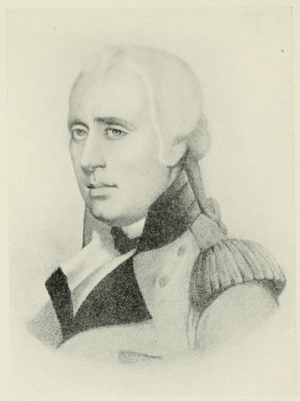Robert Kyd facts for kids
Quick facts for kids
Robert Kyd
|
|
|---|---|
 |
|
| Born | 1746 Forfarshire, Scotland, United Kingdom |
| Died | 27 May 1793 Calcutta, Bengal Presidency, British India |
| Buried |
South Park Street Cemetery
|
| Allegiance | |
| Service/ |
Bengal Army |
| Years of service | 1764-1793 |
| Rank | Colonel |
| Unit | Bengal Engineers |
Colonel Robert Kyd was a British army officer who lived from 1746 to 1793. He was stationed in India and is best known for starting the famous botanical garden in Calcutta in 1787. This garden became a very important place for studying plants.
Contents
Robert Kyd: A Pioneer in India
Early Life and Military Career
Not much is known about Robert Kyd's early life. He was born in Scotland, in a place called Forfarshire (which is now known as Angus). His father, Thomas, was a merchant. Robert Kyd might have studied medicine in Edinburgh.
He joined the Bengal Engineers, a part of the British army in India, in 1764. He quickly moved up the ranks, becoming a lieutenant a year later, a captain in 1768, a major in 1780, and a lieutenant-colonel by 1782. He also served as the Secretary to the Military Department of Inspection in Bengal until he passed away.
Founding the Botanic Garden

Robert Kyd was very interested in plants and gardening. He even had his own private garden near Howrah. He came up with the idea of creating a large botanical garden and shared it with the Governor-General, Sir John Macpherson. The idea was then sent to the leaders of the East India Company.
Why a Botanic Garden?
Kyd believed the garden could help in several ways. He thought it could find new food sources to prevent famines, which were a big problem at the time. He also wanted to identify plants that could be useful for trade and business. For example, he mentioned bringing in the sago palm from Malaya and the Persian date.
A Garden of Global Importance
The plan for the garden was approved on July 31, 1787, and Kyd was made its honorary superintendent. Kyd hoped the garden would help the East India Company find and grow important plants, allowing them to "outstrip our rivals" in valuable plant production.
By 1790, Kyd's garden had 4,000 different plants. Years later, in 1848, a famous botanist named Joseph Hooker visited the garden. He noted that it had "contributed more useful and ornamental tropical plants to the public and private gardens of the world than any other establishment before or since." This shows how important Kyd's garden became.
A type of plant called Kydia (specifically Kydia calycina) was named after him by another botanist, William Roxburgh, to honor his contributions.
His Legacy and Memorial
In his will, Robert Kyd asked to be buried in the botanical garden he founded, without any religious ceremony. However, he was instead buried in the South Park Street Cemetery.
There is a beautiful urn, a type of vase, sculpted by a Mr. Banks, that serves as a memorial to Kyd in the botanical garden he started. This memorial helps people remember his important work.
Kyd also made sure to leave money for some of his servants in his will, showing his care for them.
Family Connections
Robert Kyd had family connections in India. His cousin once removed, Major Alexander Kyd, became a Lieutenant General and Surveyor General of Bengal. Alexander Kyd's sons, James Kyd (1786-1836) and Robert (who passed away in 1825), became shipbuilders. The street named Kyd Street and the area called Kidderpore in Kolkata are named after this family.

